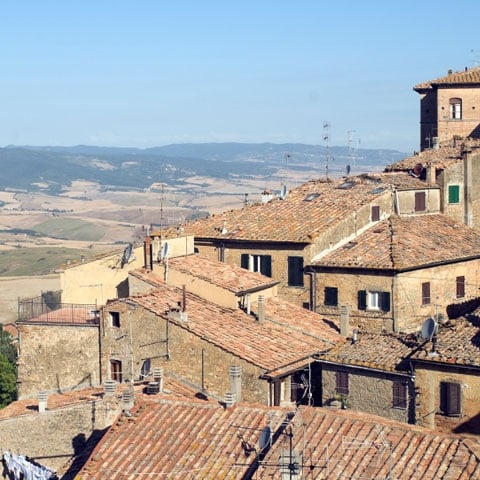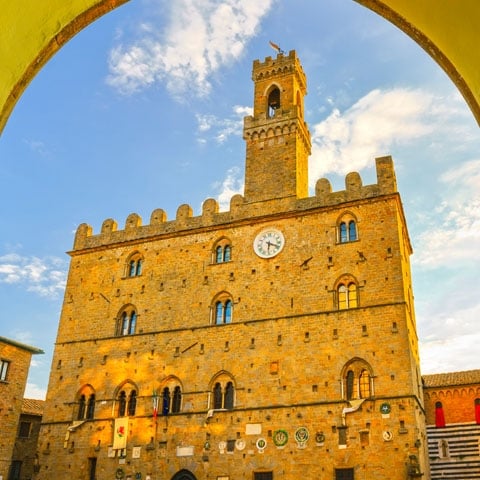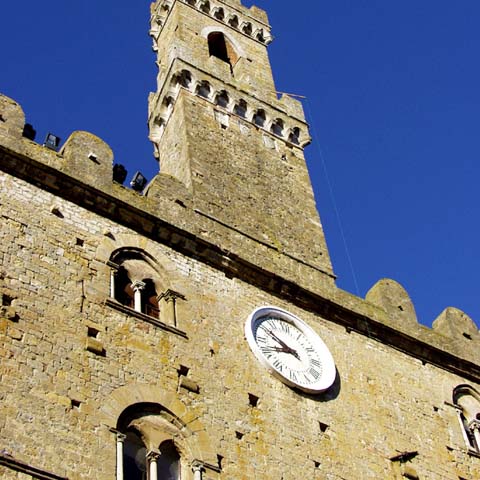The sleepy little treasure of the Tuscan hilltop town of Volterra is a perfect retreat from the crowds of some of Italy’s larger cities. Thought to be continuously inhabited since circa the eighth century BC, Volterra is steeped in ancient tradition and history. Its Etruscan, Roman, medieval, and Renaissance rulers over the centuries all influenced what the city has become today. The architecture, art, and music are all a part of this city’s legacy and contribution to the Italian culture. Whether you visit for a week or only a day, be sure to take in the beauty and charm of this enchanting city by simply exploring its streets and alleyways for a quintessential Italian adventure.
ARCHITECTURE
Although Volterra is considered to be a somewhat small town, it is home to a number of historical government buildings, palaces, and churches.
Churches are a large part of Volterra’s culture, particularly with the town being the birthplace of five popes. The buildings most notably a part of the city’s religious culture are the Volterra Cathedral and the Baptistery of Volterra.
The Volterra Cathedral of Santa Maria Assunta is unique in both appearance and purpose. This circa eleventh or twelfth century structure is located in Piazza dei Priori. The cathedral’s appearance is unique in that it features black and white patterned stripes on the back façade as many religious structures did during the time period of its construction. The front of the church is beige in color with stately white columns that were taken from the ruins of Volterra’s Roman Theater. The front façade features three circular windows, a main entryway door with an ornate overhang, and a steeple that sits atop the building. The structure’s main purpose was to be a church, but it was built back-to-back with the Palazzo dei Priori to serve the prior. The placement of the church was somewhat unusual, but was intended to serve the religious needs of the prior who was, by law, confined to the palace for his term of rule. With the cathedral backing up to the palace, the prior was able to look into the church and participate in mass without ever technically leaving the palace.
The Baptistery of Volterra is located in the smaller Piazza San Giovanni, which some of the locals and visitors alike regard as the city’s religious square. This circa thirteenth century structure also contains the black and white patterned stripes along the front of the building, with simple gray stone for the remainder. Everything from the Pisan Romanesque style to the dome to the octagonal structure of the building is either tied to the time period or has great religious meaning. If visiting the Baptistery of Volterra, consider a tour to see the altar as well as the marble and baptismal fonts.
One of the most visited ancient structures of Volterra is the Roman Theater. This theater, which is suspected to date back to the BC era, was once used to entertain thousands of spectators with plays and similar examples of the performing arts from that time period. However, over the years, the theater became abandoned and is now largely in ruins. Although it has deteriorated throughout the centuries, much of it still lives on as later generations incorporated parts of the theater ruins into other buildings, such as the Volterra Cathedral.
Porta all’Arco is one of Volterra’s only remaining Etruscan gateways. The giant stone archway appears to be made of different types of stone which indicate rebuilding and modifications during different eras. Parts of the gateway are estimated to date back to the third century BC.
ART
Daniele Ricciarelli was a famous sixteenth century painter and sculptor born in Volterra that is more commonly known as Daniele da Volterra. The work he is perhaps most credited for is somewhat controversial as it was to make Michaelangelo’s Last Judgment more conservative by adding vestments and loincloths to the figures. Ricciarelli is also known for his religious frescoes and paintings, some of which may be found in Florence’s Uffizi Gallery.
Another renowned Italian artist and sculptor is Emilio Fiaschi of the nineteenth and twentieth century. Fiaschi is thought to have been born in Volterra and often sculpted with the medium of alabaster, a mineral for which the city is well known. He is also said to have had ties to Florence where historians believe he studied art.
LITERATURE
One of the primary literary figures of the city is renowned first century Roman poet, Persius Flaccus. He is believed to have been born in Volterra and be of Etruscan origin. Flaccus is best known for writing poems and satires, much of which became popular primarily after his death.
Thirteenth century Italian poet Jacopo da Leona spent much of his career in Volterra where he became a judge and wrote a sonnet songbook. His writings were mainly of poetry and satire and one of his best-known works is considered to be Madonna, di voi piango e mi lamento.
Volterra was commonly used as a backdrop or featured in literary works tracing all the way back to the fifteenth century. Examples include Forse che sì forse che no by Gabriele D’Annunzio, several of Carlo Cassola’s works, the poem Horatius by Lord Macaulay, On Love by Stendhal, the Captain Nicholas Ramage series of novels by Dudley Pope, and Chimaira by Valerio Massimo Manfredi. One of the more modern literary examples is the town’s role as a location in the Twilight series by Stephanie Meyer.
MUSIC
One of the larger musical events of Volterra is known as the Volterra Teatro Festival. Each summer, usually in July, the festival celebrates various types of classical and modern music that still have a place in Volterra’s culture.
CINEMA
Because of Volterra’s hilltop location and relatively small size, it is still largely unused as a setting in cinematography. However, in 1964, famed Italian director Luchino Visconti chose some rooms of Volterra’s Incontri-Viti Palace to shoot Vaghe Stelle dell’Orsa…, a film that was awarded the Venice Film Festival’s Golden Lion.
Additionally, the city’s scenery was captured, so to speak, in a twenty-first century video game called The Town of Light, and in Fumihiko Sori’s Fullmetal Alchemist (2017). Other movies filmed in Volterra include Camminacammina (1981), Prima la musica, poi le parole (1998), Milonga (1999), Mondovino (2004), and The Music of Silence (2017).
With the city’s quintessential Italian vibe, romantic corners, and cozy walkways and alleys, it would not be surprising to see the city garner the attention of budding producers and directors in the coming years.
SCIENCE
Volterra’s natural history can be explored in depth at the Museo Etrusco Guarnacci. The museum is believed to host one of the largest collections of Etruscan artifacts in Italy. Opened during the eighteenth century, the museum’s exhibits feature funerary urns, bas-reliefs, bones, vases, and countless other objects tied to the Etruscan civilization.















